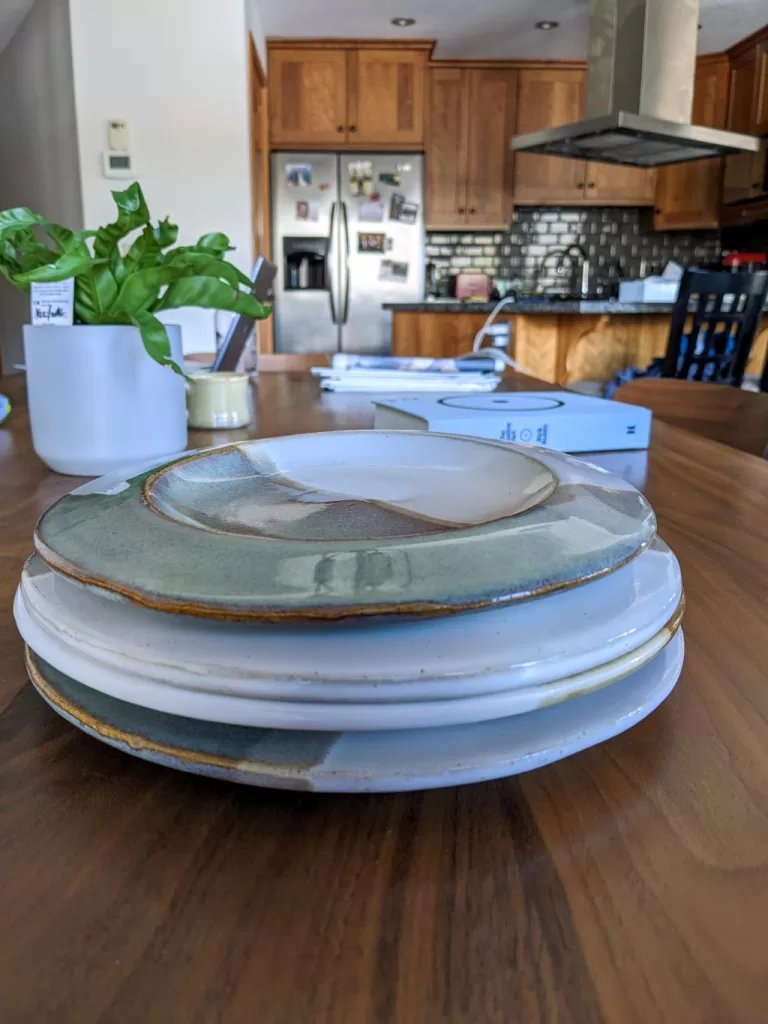Creating A Pottery Plate Set You Love
This winter, I had a goal of creating a set of pottery dinner plates for my home. This is my first set and I’m now obsessed with plates. I’m no expert or teacher. My goal here is to share my “lessons learned” for fellow potters so you will avoid my mistakes and create a pottery plate set you love. Let me take you through the process and my lessons learned!

Creating Sets Workshop with John Borrowman
I took a wonderful weekend workshop at ArtsPlace in Canmore with well-known potter and former town Mayor, John Borrowman. In his class I learned how to throw a flange, which I found immensely satisfying. For my first set, I decided to go with the flange design, despite my “typical” preference for minimalism, mostly because of the fun I had throwing them. It’s curious – the styles I don’t find aesthetically appealing are more fun to create so I’m finding as my pottery journey continues, my style is also evolving.
I think it is also beneficial to try different styles and know the techniques that might not be your favourite – you never know where your creative journey will take you.
How Much Clay Do I Need to Throw a Plate?
It’s shocking, but for me, it is 4 pounds for one plate. Then, there is a lot of room to trim the bottom of your plate for an attractive foot and to mimic the curve of the surface of the plate.
Extra Tools You Will Find Helpful to Make Plates
- Calipers
- Long Rib
- Throwing Bats
How to Support a Dramatic Flange
I found out the hard way that it was best to throw as wide as possible for the plate surface. From there, it’s important when you pull the rim up and out for the flange that you will have enough vertical support from the bottom of the plate to support and keep the flange from drooping. You can see the droop I have in two of my plates in the photos below.
What Size Should Your Plates Be?
My plates were thrown to be 10 inches in diameter including the flange. So, this set has 8 inch diameter of eating space and 2 inch wide flange. Honestly, they are too small to be a dinner plate. It’s like a really fancy and heavy side plate. I like smaller plate sizes to keep my portion sizes reasonable but I think they are too small for my partner or dinner guests.
Next time, I would want to calculate 10 inches of eating surface and then add the flange.
Lessons Learned for Trimming with Stacking in Mind
Here is an example of bad stacking. At least, I’m not satisfied with it and feel there is room for a lot of improvement.

Here’s where I think I went wrong:
- Documenting the sizes of my previous plates and making sure to throw to that size with the caliper tool. I think I did one of these by “feel”. You can see here that the top plate is smaller than the rest of the set.
- Next time, I will use calipers or a ruler to increase consistency of size in foot trimming so the plates can nest nicely. John Borrowman used a wide jar lid; he placed that in the middle of the bottom of the plate and trimmed around it to create the plate foot. It’s a cool trick and good for consistency.
Lessons with Glazes and Clay Bodies

As you can see here, these two plates are different despite having used the same glaze.
I used Rutile glaze and White glaze with the same thickness. The difference is the purple-hue Rutile (see right plate) is on M370 by Plainsman and the Rutile turquoise hue (see left plate) is on M340 by Plainsman. I never would have expected such a dramatic difference in the glazes on these clay bodies and I learned an important lesson for the future if I want strong consistency in the set.

Questions to Ask Yourself Before Making a Plate Set
- How would I like to “frame my meal” with the plate?
- What shape do I want? How much food do I typically have in a serving? Ask family members too.
- Do I want a flange to rest bread on? Or as a big frame for the meal?
- Do I want a different shape to hold a certain cuisine? Japanese? Indian? Try to do some research into their pottery traditions.
- Is this an every day dinner set or do I want to create set for special occasions?
- Do I have enough clay for the amount of plates I want to make? Have extra clay for some duds.
Hopefully, later this year I will have a more successful set to share but in any case, I learned a lot from this first attempt.



Leave a Reply